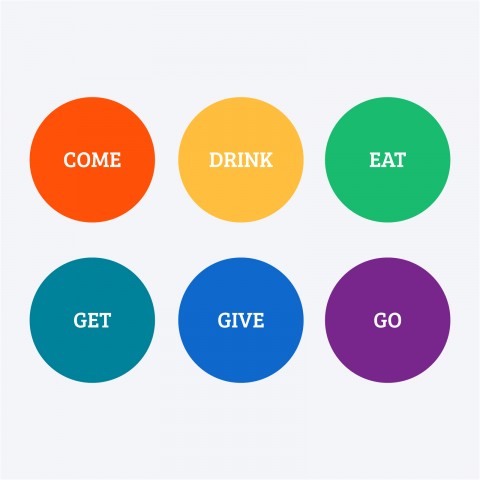
Have you reached the intermediate level of Dutch and can no longer be called a beginner?
Congratulations! This is an amazing achievement. You’ve found the energy and a successful learning routine to master the beginner level.
However, this is also when your Dutch language learning journey gets more difficult. As you begin learning the intermediate Dutch words and phrases, your progress will slow down and become less linear than it was at the beginning. You’ve got a good basic vocabulary and a decent bit of grammar knowledge, but how do you go from basic to advanced?
In this article, we’ll list the most common intermediate Dutch words you should learn to slowly improve your Dutch and reach the next level. From pronouns and numbers to prepositions, this guide will give you the boost you need to reach—and master—the intermediate level in Dutch!

Let’s master the intermediate Dutch level!
 Table of Contents
Table of Contents
- Pronouns
- Verbs
- Numbers
- Nouns
- Conjunctions
- Adjectives
- Adverbs
- Prepositions
- How DutchPod101 Can Help You Learn More Dutch
1. Pronouns
You probably already manage various Dutch pronouns at this point, such as the personal subject pronouns (ik, zij, jij, wij), the impersonal pronoun (het – “it”), and even the demonstrative, interrogative, and indefinite pronouns.
Now it’s time to move on to some intermediate Dutch grammar stuff with these next-level pronouns.
1 – Possessive Pronouns
A possessive pronoun indicates ownership:
- Dat is mijn boek. (“That’s my book.”)
However, it does not always mean that someone owns something in a literal sense, as you can see in the next examples:
- Haar vliegtuig heeft vertraging. (“Her plane is delayed.”)
- Hij is mijn vriend. (“He is my boyfriend.”)
Let’s have a look at the Dutch possessive pronouns:
| Dutch | English |
| Singular | |
| Mijn | “My” |
| Jouw (casual with emphasis) Je (casual without emphasis) Uw (formal) | “Your” |
| ZijnHaar | “His” “Her” |
| Plural | |
| Ons (het-nouns) Onze (de-nouns and plural nouns) | “Our” |
| Jullie (casual) Uw (formal) | “Your” |
| Hun | “Their” |
2 – Objective Personal Pronouns
Objective personal pronouns take the place of the sentence’s object, rather than its subject:
- Zij kent mij. (“She knows me.”)
- Daan praatte met hem. (“Daan spoke with him.”)
In these sentences, mij and hem are the objective personal pronouns. Let’s have a look at the rest:
| Dutch | English |
| Singular | |
| Me Mij | “Me” |
| Jou (casual with emphasis) Je (casual without emphasis) U (formal) | “You” |
| Hem Haar | “Him” “Her” |
| Plural | |
| Ons | “Us” |
| Jullie (casual) U (formal) | “You” |
| Hun Hen | “Them” |
3 – Reflexive Pronouns
Reflexive pronouns replace the objective personal pronoun when someone is doing something to themselves:
- Ik was me. (“I wash myself.”)
- Ze schamen zich. (“They are ashamed of themselves.”)
| Dutch | English |
| Singular | |
| Me | “Myself” |
| Je (casual) U (formal) Zich (formal) | “Yourself” |
| Zich (singular) | “Himself” “Herself” “Itself” |
| Plural | |
| Ons | “Ourselves” |
| Je (casual) U (formal) | “Yourselves” |
| Zich (plural) | “Themselves” |
4 – Reciprocal Pronouns
The Dutch word elkaar (“each other”) is a reciprocal pronoun. It can only be used for plural subjects that are doing something to each other:
- Wij kennen elkaar. (“We know each other.”)
- Zij praatten met elkaar. (“They talked to each other.”)
- Zij gaven elkaar de hand. (“They shook each other’s hands.”)

This is another example of where you could use the reciprocal pronoun elkaar. Do you know how?
- → Would you like to learn the pronunciation of these (and other) Dutch pronouns? Then have a look at our Most Useful Pronouns vocabulary list with audio recordings.
2. Verbs
You must already know the most common Dutch verbs for beginners, such as zijn (“to be”) and hebben (“to have”). Now it’s time to expand your vocabulary with some key intermediate Dutch verbs.
- → For more detailed information on the topic, be sure to have a look at our full article on Dutch verbs.
| Serveren | “To serve” |
| Verlaten | “To leave” |
| Laten | “To allow” / “To let” |
| Verzenden | “To send” |
| Ontvangen | “To receive” |
| Leven | “To live” |
| Bellen | “To call” |
| Terugbellen | “To call back” |
| Presenteren | “To present” |
| Voorstellen | “To introduce” / “To propose” |
| Accepteren | “To accept” |
| Weigeren | “To refuse” |
| Acteren | “To act” |
| Spelen | “To play” |
| Herkennen | “To recognize” |
| Erkennen | “To acknowledge” |
| Kiezen | “To choose” / “To select” |
| Selecteren | “To select” |
| Aanraken | “To touch” |
| Opstaan | “To stand up” / “To get out of bed” |
| Winnen | “To win” |
| Verdienen | “To earn” |
| Verliezen | “To lose” |
| Bestaan | “To exist” |
| Slagen | “To succeed” |
| Veranderen | “To change” |
| Werken | “To work” |
| Lopen | “To walk” |
| Proberen | “To try” / “To attempt” |
| Voorkomen | “To prevent” |
| Stoppen | “To stop” |
| Hervatten | “To resume” |
| Terugnemen | “To take back” |
| Koken | “To cook” |
| Behoren | “To belong” |
| Riskeren | “To risk” |
| Ontmoeten | “To meet” |
| Creëren | “To create” |
| Krijgen | “To get” |
| Binnengaan | “To enter” |
| Verlaten | “To exit” / “To go out” / “To leave” |
| Aanbieden | “To offer” |
| Brengen | “To bring” |
| Gebruiken | “To use” |
| Bereiken | “To reach” / “To achieve” |
| Bereiden | “To make” / “To prepare” |
| Voorbereiden | “To prepare” |
| Toevoegen | “To add” |
| Betalen | “To pay” |
| Overwegen | “To consider” |
| Bestuderen | “To study” |
| Kopen | “To buy” |
| Kopen | “To buy” |
| Duwen | “To push” |
| Trekken | “To pull” |
| Vertrekken | “To leave” / “To depart” |
| Reizen | “To travel” |

What other intermediate Dutch verbs would you like to know?
3. Numbers
You already know the basic numbers and can count from 1 to 10 in Dutch like a local. Now it’s time to go a step further and add larger numbers to your intermediate Dutch vocabulary. Learning higher numbers will allow you to handle higher prices, years, or ages.
Let’s have a look.
1 – From 10 to 20
| 10 | Tien |
| 11 | Elf |
| 12 | Twaalf |
| 13 | Dertien |
| 14 | Veertien |
| 15 | Vijftien |
| 16 | Zestien |
| 17 | Zeventien |
| 18 | Achttien |
| 19 | Negentien |
| 20 | Twintig |
2 – Counting Up to 100
| 30 | Dertig |
| 40 | Veertig |
| 50 | Vijftig |
| 60 | Zestig |
| 70 | Zeventig |
| 80 | Tachtig |
| 90 | Negentig |
| 100 | Honderd |
3 – To 1000 and Beyond
| 200 | Tweehonderd |
| 300 | Driehonderd |
| 400 | Vierhonderd |
| 500 | Vijfhonderd |
| 600 | Zeshonderd |
| 700 | Zevenhonderd |
| 800 | Achthonderd |
| 900 | Negenhonderd |
And from there, the sky’s the limit!
| 1,000 | Duizend |
| 10,000 | Tienduizend |
| 100,000 | Honderdduizend |
| 1,000,000 (106) | Eén miljoen |
Would you like to see some other examples of Dutch numbers and to hear their pronunciation? Then have a look at our Dutch Numbers vocabulary list.
4. Nouns
The more nouns you know, the greater diversity of conversations you’ll be able to have! Below we’ve included some useful nouns in different categories for the intermediate Dutch level.
1 – Time
| Toekomst | “Future” |
| Seizoen | “Season” |
| Lente | “Spring” |
| Zomer | “Summer” |
| Winter | “Winter” |
| Herfst | “Autumn” |
| Eeuw | “Century” |
| Trimester | “Trimester” / “Quarter” |
| Semester | “Semester” |
2 – Places
| Regio | “Region” |
| Provincie | “Province” |
| The Netherlands is divided into 12 provinces. | |
| Dorp | “Village” |
| Stad | “City” |
| Park | “Park” |
| Bank | “Bank” |
| Apotheek | “Pharmacy” |
| Ziekenhuis | “Hospital” |
| Bakkerij | “Bakery” |
| Supermarkt | “Supermarket” |
| Drogist | “Drugstore” |
| Vlakte | “Plain” |
| Klif | “Cliff” |
| Strand | “Beach” |
| Eiland | “Island” |
| Heuvel | “Hill” |
3 – Technology
| Toetsenbord | “Keyboard” |
| A lot of Dutch people also use the English word “keyboard.” | |
| Muis | “Mouse” |
| Just like in English, muis is also the word for the cute furry animal. | |
| Tablet | “Tablet” |
| Televisie | “Television” |
| Oplader | “Charger” |
| Website | “Website” |
| Account | “Account” |
| Wachtwoord | “Password” |
| Bestand | “File” |
| Map | “Folder” |
| Software | “Software” |

Are you ready to bring these intermediate Dutch nouns into practice?
4 – Home
| Kamer | “Room” |
| Verdieping | “Floor” / “Story” |
| Woonkamer | “Living room” |
| Badkamer | “Bathroom” |
| Koelkast | “Fridge” |
| Kast | “Cabinet” / “Wardrobe” / “Cupboard” / “Closet” |
5 – City & Transportation
| Buitenwijk | “Suburb” |
| Buurt | “Neighborhood” / “Area” |
| Snelweg | “Highway” |
| Steeg | “Alley” |
| Rotonde | “Roundabout” |
| Kruispunt | “Crossroad” / “Intersection” / “Junction” |
6 – People
| Oom | “Uncle” |
| Tante | “Aunt” |
| Kleinzoon | “Grandson” |
| Kleindochter | “Granddaughter” |
| Baby | “Baby” |
| Grootvader | “Grandfather” |
| Grootmoeder | “Grandmother” |
7 – Body Parts
| Vinger | “Finger” |
| Rug | “Back” |
| Buik | “Belly” |
| Borst | “Breast” |
| Schouder | “Shoulder” |
| Been | “Leg” |
| Dij | “Thigh” |
| Bil | “Butt cheek” |
| Voet | “Foot” |
| Wang | “Cheek” |
| Kin | “Chin” |
| Voorhoofd | “Forehead” |
8 – Food
| Mes | “Knife” |
| Vork | “Fork” |
| Lepel | “Spoon” |
| Gerecht | “Dish” |
| Voorgerecht | “Starter” |
| Hoofdgerecht | “Main dish” / “Main course” |
| Nagerecht | “Dessert” |
| Drankje | “Drink” |
| Wijn | “Wine” |
9 – Work & Studies
| Verpleegkundige | “Nurse” |
| Politieagent | “Police officer” |
| Advocaat | “Lawyer” |
| Ober | “Waiter” |
| Universiteit | “University” |
10 – Clothes
| Broek | “Pants” / “Trousers” |
| Trui | “Sweater” |
| T-shirt | “T-shirt” |
| Overhemd | “Shirt” |
| Jas | “Coat” / “Jacket” |
| Sok | “Sock” |
| Schoen | “Shoe” |
| Jurk | “Dress” |
| Hoed | “Hat” |

Can you already talk about clothes in Dutch?
5. Conjunctions
Let’s have a look at the more complex conjunctions and see how they work in real-life sentences:
Noch (“Nor”)
- Ik drink noch bier noch wijn. (“I drink neither beer nor wine.”)
Dus (“Then” / “So”)
- Ik heb geen dorst, dus ik drink niet. (“I’m not thirsty, so I don’t drink.”)
Anders (“Otherwise”)
- Ik drink niet, anders kan ik niet rijden. (“I’m not drinking; otherwise, I could not drive.”)
Aangezien (“Since” / “As”)
- Aangezien je hier nu bent, wil je binnenkomen? (“Since you’re here now, do you want to come in?”)
Als (“When”)
- Als ik moe ben, dan gaap ik. (“When I’m tired, I yawn.”)
Daarom (“Therefore” / “Thus”)
- Ik heb niks gegeten en daarom heb ik honger. (“I have not eaten anything, and therefore I am hungry.”)
6. Adjectives
Although not as essential for beginners who just want to express basic ideas, adjectives are a great way for intermediate Dutch students to make their sentences more meaningful and give them more flavor.
| Geweldig | “Great” / “Awesome” / “Amazing” |
| Fantastisch | “Fantastic” / “Great” |
| Verschrikkelijk | “Horrible” |
| Raar | “Weird” / “Strange” |
| Bizar | “Bizarre” |
| Ingewikkeld | “Complicated” |
| Dichtbij | “Near” |
| Ver | “Far” |
| Smal | “Narrow” |
| Wijd | “Wide” |
| Zacht | “Soft” |
| Hard | “Hard” |
| Vol | “Full” |
| Leeg | “Empty” |
| Licht | “Light” |
| Zwaar | “Heavy” |
| Uniek | “Unique” |
| Speciaal | “Special” |
| Bijzonder | “Particular” / “Special” |
| Nieuw | “New” |
| Arm | “Poor” |
| Rijk | “Rich” / “Wealthy” |
| Schoon | “Clean” |
| Vies | “Dirty” |
| Zwak | “Weak” |
| Slank | “Slim” |
| Schattig | “Cute” |
| Gemeen | “Mean” |
| Grappig | “Funny” |
| Leuk | “Nice” / “Fun” |
| Gelukkig | “Happy” / “Fortunate” |
| Verdrietig | “Sad” |
| Rustig | “Quiet” / “Calm” |
| Enthousiast | “Excited” |
| Gevaarlijk | “Dangerous” |
| Saai | “Boring” |
| Vettig | “Greasy” / “Fatty” |
| Pittig | “Spicy” |
| Tweede | “Second” |
| Volgende | “Next” |
| Vorige | “Previous” |
| Eén na laatste | “Penultimate” / “Second-to-last” |
| Oranje | “Orange” |
| Roze | “Pink” |
| Grijs | “Gray” |
| Paars | “Purple” |
| Magenta | “Magenta” |
| Turquoise | “Turquoise” |
- → Would you like to learn more adjectives? Have a look at our Most Common Adjectives vocabulary list with useful audio recordings to practice your pronunciation.

What Dutch adjective would you use to give someone a compliment?
7. Adverbs
Like with adjectives, you could get away with very few adverbs as a beginner—but you’ll need to learn more as you approach the intermediate Dutch level. Using adverbs will not only improve your writing style and skills, but also help you explain yourself more clearly.
1 – When
| Al | “Already” |
| Lang geleden | “A long time ago” |
| Nu | “Now” |
| Weer | “Again” |
| Eindelijk | “At last” / “Finally” |
| Toen | “Then” |
2 – How Often
| Soms | “Sometimes” |
| Zelden | “Rarely” |
| Meestal | “Usually” |
| Doorgaans | “Generally” / “Usually” |
| Voortdurend | “Constantly” |
3 – Where

Use these Dutch adverbs when you’re looking for something.
| Ergens anders | “Somewhere else” |
| Boven | “Above” |
| Onder | “Below” |
| Over | “Over” |
| Op | “On” |
| Naast | “Beside” |
| Om | “Around” |
4 – How
| Zacht(jes) | “Softly” |
| Stil(letjes) | “Quietly” |
| Langzaam | “Slowly” |
| Snel | “Fast” / “Quickly” / “Shortly” |
| Rustig | “Calmly” / “Quietly” |
| Gemakkelijk | “Easily” |
| Gelukkig | “Luckily” |
| Gewoon | “Simply” / “Just” |
5 – How Much
| Eerder | “Rather” |
| Genoeg | “Enough” |
| Voornamelijk | “Especially” |
| Bijna | “Almost” |
| Hoeveel | “How much” / “How many” |
| Zoveel | “So much” / “So many” |
| Ongeveer | “About” / “Approximately” |
- → Would you like to discover other Dutch adverbs and practice your pronunciation? Then have a look at our Essential Adverbs of Frequency and Time vocabulary list with audio recordings.
8. Prepositions
Prepositions are vital for helping us structure our sentences, as they mark the relationships and links between people, objects, places, and moments. You don’t need many of them, but as an intermediate Dutch learner, it’s crucial to know at least a few of these prepositions.
1 – Time
| Voor | “Before” |
| Na | “After” |
| Tijdens | “During” |
2 – Space
| Tegen | “Against” |
| Naar rechts | “To the right” |
| Naar links | “To the left” |
| Bij | “At” |
| Voor | “In front of” / “Ahead” |
| Achter | “Behind” |
| Naar beneden | “Down” |
| Naar boven | “Up” |
| Op | “On” |
3 – Other
| Tussen | “Between” / “Among” |
| Dankzij | “Thanks to” |
| Ondanks | “Despite” |
| Zonder | “Without” |
9. How DutchPod101 Can Help You Learn More Dutch

Let DutchPod101 help you master the intermediate Dutch level.
In this guide, you’ve seen over 300 of the most useful intermediate Dutch words and phrases in a number of different word categories. You might have already known several of them, but now you have them all conveniently gathered in one place.
- → Want to expand your Dutch vocabulary even further? Make sure to visit our vocabulary lists Most Useful Pronouns, 50 Most Common Adjectives, and 50 Most Common Nouns.
Are there any intermediate Dutch words you think we missed? Let us know in the comments, and we’ll get back to you as soon as possible!
You can begin practicing and reviewing these 300+ intermediate Dutch words with the help of DutchPod101’s vocabulary lists with audio recordings and our other free resources designed to boost your studies.
Would you like some special attention? Remember that we also offer a Premium PLUS service with personal 1-on-1 coaching: MyTeacher. Let your private teacher help you master the intermediate Dutch level through personalized exercises, constructive feedback, and interactive assignments.
Interested in some other intermediate Dutch lessons? Then we recommend checking out our Intermediate lesson series, which contains 25 lessons that focus on natural dialogue and strive to help you improve your language skills in all key areas: reading, writing, speaking, and listening.
Happy learning on DutchPod101.com!










